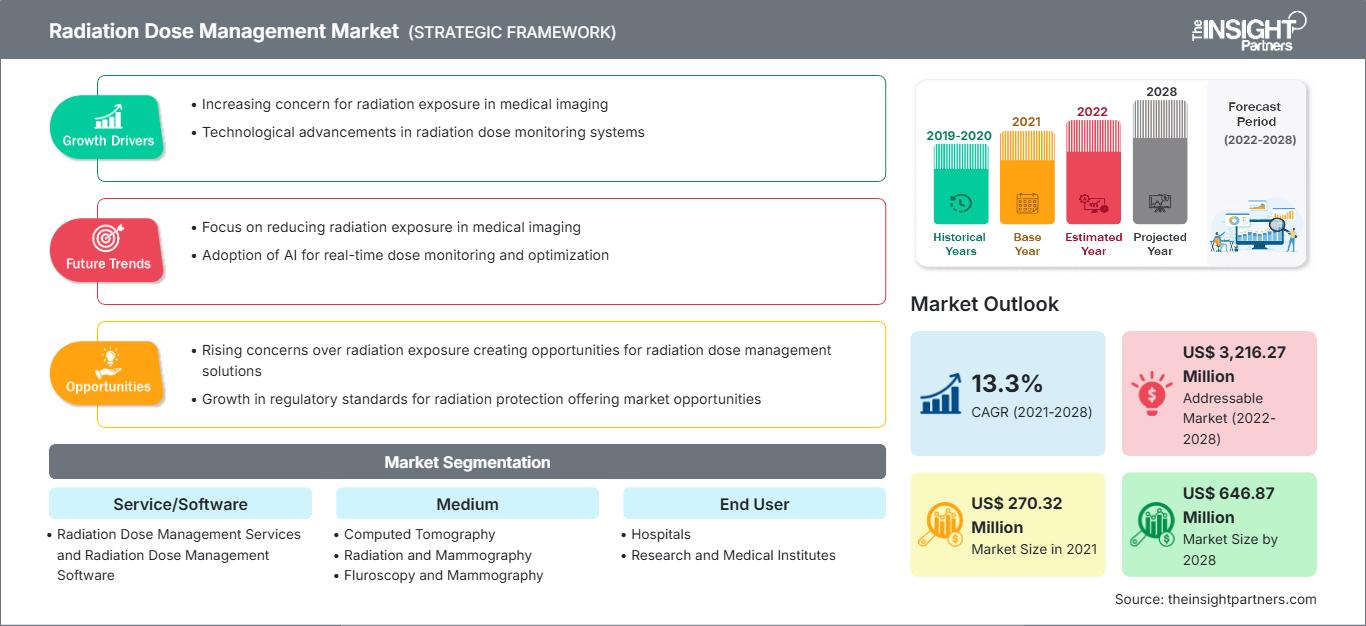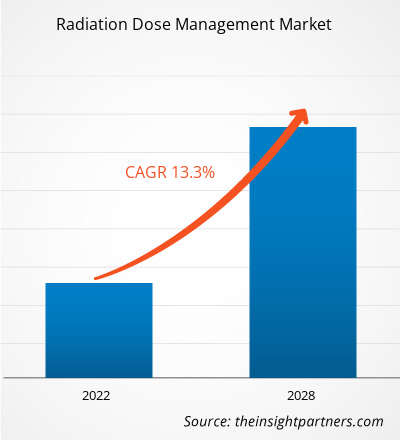Si prevede che il mercato della gestione della dose di radiazioni raggiungerà i 646,87 milioni di dollari entro il 2028, rispetto ai 270,32 milioni di dollari del 2021; si stima una crescita a un CAGR del 13,3% nel periodo 2021-2028.
La radioterapia è una branca essenziale della scienza medica. Diverse malattie come il cancro, le malattie cardiovascolari, ecc. vengono diagnosticate e trattate tramite onde elettromagnetiche. È ampiamente utilizzata per trattare diversi tipi di cancro. Tuttavia, la radioterapia ha anche effetti collaterali. Pertanto, il monitoraggio della corretta dose di radiazioni è fondamentale in qualsiasi procedura medica basata sulle radiazioni. La dose di radiazioni è la quantità di radiazioni irradiata al paziente. La gestione della dose di radiazioni comprende informazioni sul software di registrazione della dose di radiazioni; il monitoraggio della dose da parte del personale in tempo reale; la conformità normativa; e le tecnologie di riduzione della dose, come il software di ricostruzione interattiva.
La crescita del mercato della gestione della dose di radiazioni è attribuita alle crescenti preoccupazioni legate all'esposizione alle radiazioni e all'aumento dei casi di cancro che richiedono radioterapia. Tuttavia, le sfide organizzative e la mancanza di benchmarking per l'ottimizzazione della dose ostacolano la crescita del mercato.
Personalizza questo rapporto in base alle tue esigenze
Potrai personalizzare gratuitamente qualsiasi rapporto, comprese parti di questo rapporto, o analisi a livello di paese, pacchetto dati Excel, oltre a usufruire di grandi offerte e sconti per start-up e università
Mercato della gestione della dose di radiazioni: Approfondimenti strategici

-
Ottieni le principali tendenze chiave del mercato di questo rapporto.Questo campione GRATUITO includerà l'analisi dei dati, che vanno dalle tendenze di mercato alle stime e alle previsioni.
Approfondimenti di mercato
Crescente attenzione alla radiologia interventistica e alla medicina nucleare
I rapidi progressi nella tecnologia medica, nella produzione di dispositivi e nelle apparecchiature di imaging hanno portato al perfezionamento delle procedure originali con tecniche migliori e a un ampliamento delle indicazioni per le procedure. Sono state sviluppate nuove tecniche e alcune tecniche sono state migrate ad altre modalità di imaging. Grazie all'elevata efficienza di imaging, in tutto il mondo vengono eseguite più procedure di radiologia interventistica e di medicina nucleare. Secondo la Society of Nuclear Medicine, negli Stati Uniti vengono eseguite circa 20 milioni di procedure di medicina nucleare ogni anno. Come riportato dalla World Nuclear Association, oltre 10.000 ospedali in tutto il mondo utilizzano radioisotopi in medicina e il 90% delle procedure con radioisotopi è diagnostico. Operatori del mercato come Bayer Healthcare e Sectra Medical Systems offrono software di gestione della dose specifico per la radiologia interventistica e la medicina nucleare. Pertanto, la crescente attenzione alla radiologia interventistica e alla medicina nucleare sta offrendo opportunità di crescita per il mercato.
Approfondimenti basati su servizi/software
In base ai servizi/software, il mercato globale della gestione della dose di radiazioni è stato segmentato in servizi di gestione della dose di radiazioni e software di gestione della dose di radiazioni. Il segmento del software di gestione della dose di radiazioni ha detenuto la quota maggiore del mercato nel 2021 e si prevede che registrerà un CAGR del 13,6% durante il periodo di previsione.
Approfondimenti basati sul mezzo
In base al mezzo, il mercato globale della gestione della dose di radiazioni è segmentato in tomografia computerizzata, radioterapia e mammografia, fluoroscopia e mammografia e altri mezzi. Il segmento della tomografia computerizzata ha detenuto la quota maggiore del mercato nel 2021 e si prevede che registrerà un CAGR del 13,8% durante il periodo di previsione.
Approfondimenti regionali sul mercato della gestione della dose di radiazioni
Le tendenze regionali e i fattori che influenzano il mercato della gestione della dose di radiazioni durante il periodo di previsione sono stati ampiamente spiegati dagli analisti di The Insight Partners. Questa sezione illustra anche i segmenti e la geografia del mercato della gestione della dose di radiazioni in Nord America, Europa, Asia-Pacifico, Medio Oriente e Africa, America meridionale e centrale.
Ambito del rapporto di mercato sulla gestione della dose di radiazioni
| Attributo del rapporto | Dettagli |
|---|---|
| Dimensioni del mercato in 2021 | US$ 270.32 Million |
| Dimensioni del mercato per 2028 | US$ 646.87 Million |
| CAGR globale (2021 - 2028) | 13.3% |
| Dati storici | 2019-2020 |
| Periodo di previsione | 2022-2028 |
| Segmenti coperti |
By Servizi/Software
|
| Regioni e paesi coperti |
Nord America
|
| Leader di mercato e profili aziendali chiave |
|
Densità degli operatori del mercato della gestione della dose di radiazioni: comprendere il suo impatto sulle dinamiche aziendali
Il mercato della gestione della dose di radiazioni è in rapida crescita, trainato dalla crescente domanda degli utenti finali dovuta a fattori quali l'evoluzione delle preferenze dei consumatori, i progressi tecnologici e una maggiore consapevolezza dei benefici del prodotto. Con l'aumento della domanda, le aziende stanno ampliando la propria offerta, innovando per soddisfare le esigenze dei consumatori e sfruttando le tendenze emergenti, alimentando ulteriormente la crescita del mercato.

- Ottieni il Mercato della gestione della dose di radiazioni Panoramica dei principali attori chiave
Approfondimenti basati sull'utente finale
In base all'utente finale, il mercato della gestione della dose di radiazioni è segmentato in ospedali, istituti di ricerca e medici e altri. Il segmento ospedaliero ha detenuto la quota maggiore del mercato nel 2021 e si stima che registrerà il CAGR più elevato del mercato, pari al 13,6%, durante il periodo di previsione.
Il lancio e l'approvazione dei prodotti sono strategie comunemente adottate dalle aziende per espandere la propria presenza globale e il proprio portafoglio prodotti. Inoltre, gli operatori del mercato della gestione della dose di radiazioni si concentrano sulla strategia di partnership per espandere la propria clientela, il che, a sua volta, consente loro di mantenere il proprio marchio in tutto il mondo.
Profili aziendali
- FUJIFILM Holdings Corporation
- Bayer AG
- Bracco Imaging SpA
- GE Healthcare
- Koninklijke Philips NV
- Medsquare
- Novarad Corporation
- QAELUM INC
- Sectra AB
- PACSHealth, LLC
- Analisi storica (2 anni), anno base, previsione (7 anni) con CAGR
- Analisi PEST e SWOT
- Valore/volume delle dimensioni del mercato - Globale, Regionale, Nazionale
- Industria e panorama competitivo
- Set di dati Excel
Report recenti
Rapporti correlati
Testimonianze
Motivo dell'acquisto
- Processo decisionale informato
- Comprensione delle dinamiche di mercato
- Analisi competitiva
- Analisi dei clienti
- Previsioni di mercato
- Mitigazione del rischio
- Pianificazione strategica
- Giustificazione degli investimenti
- Identificazione dei mercati emergenti
- Miglioramento delle strategie di marketing
- Aumento dell'efficienza operativa
- Allineamento alle tendenze normative






















 Ottieni un campione gratuito per - Mercato della gestione della dose di radiazioni
Ottieni un campione gratuito per - Mercato della gestione della dose di radiazioni